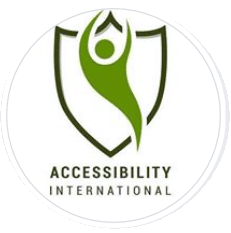What Does Web Accessibility Mean to the Disabled?
Most of us are familiar with how Accessibility applies to physical barriers in places of business. The courts describe public spaces as “places of public accomodation.” What this does is give a legal definition to places covered by the Americans with Disabilities Act.
However, till recently, little thought has been given to how Accessibility applies to the Internet. Internet Accessibility is best described as “Web Accessibility.” To have real and meaningful accessibility on the World Wide Web demands that we break down barriers and open a clear path for everyone to have equal access.
This means that web pages must be designed so that those with Visual, Hearing, Motor and Cognitive disabilities have an equal opportunity to navigate and access every web page.
What is the Web Accessibility Revolution?
The adoption of mobile technology was the impetus behind the first big revolution in web design. The Web Accessibility Revolution is the second revolution to emerge in web design. You may not have realized it, but we’re already in it and many are unaware of what web accessibility actually means.
The forces which created the pressure for these changes are very different. Also, the scope of these forces, and the cost of ignoring these forces are also quite different.

However, today many sites are still not accessible for disabled individuals. The need for web designers to adapt to mobile technology came through consumer demand, however, it did not happen immediately.
Consumer Demand Drove the 1st Web Revolution
New Technology Drove the First Web Revolution
The demand from consumers adopting new technology to access the web, and from businesses wanting to reach those users drove the mobile revolution. The cost varied by the category and company for reaching the new mobile users.

Consumers gradually embraced mobile technology and began transacting using their phones and this delayed this cost further. Demand quickly grew and was strong enough to force the change needed to support the technology.
Adopting Mobile Technology was optional, Web Accessibility isn’t.
When Lawyers Sue, Nobody Wins
The new Web Accessibility model is the same for lawyers, but this time they are investigating the digital Web Accessibility/ADA standard. It costs them almost nothing and can be done in minutes. A quick automated scan of any website can generate a report with dozens or more ADA/Web Accessibility violations.
They just paste the digital report into a demand letter template, or even a Federal complaint and out it goes landing in a business mailbox. Within days an often clueless website owner gets a rude awakening.
Only Lawyers Profit From Web Accessibility Uncertainty
Of Those Sued, Most Will Settle
A few will fight back, however most business website owners will settle their case to avoid a court room battle.. You can’t win these Web Accessibility cases so the plaintiff firms are simply printing money.
It’s a simple model, with no barrier to entry and extremely easy to mass produce.
Only Lawyers Profit From Web Accessibility Uncertainty
The only guidance web designers have about web accessibility are the Web Content Accessibility Guidelines from the World Wide Web Consortium. These are only guidelines and do not provide the certainty which statutory rules or regulations could provide.
Bar Associations lobbied hard against the Department of Justice plans to provide clear Web Accessibility rules and regulations and succeeded. The DOJ has delayed since 2010 and has now removed any pretext of acting on the implementation of Web Accessibility regulations.
We need written Web Accessibility rules and Congress could fix this. However, there is little to be gained politically by angering the powerful legal community anxious to make the easy money through threats of litigation over Accessibility against website owners.
Its all left to the lawyers and judges and a new cottage industry is going to quickly grow from the lack of Web Accessibility laws and regulations.
Web Accessibility Claims Enrich Attorneys
The Mobile Revolution was market driven and grew from the adoption of new mobile technology. However, the Web Accessibility Revolution is being driven by threats of legal action.
Just the threat of possible lawsuits has spurred many entities to remove content from their websites. They just don’t want to be subject to the hassle of constant litigation. Lawyers are aggressive and there is a lot of money up for grabs.
Lawyers can easily file a Web Accessibility claim under the Americans with Disabilities Act. They don’t even have to have an injured client to file a claim.
Embrace Universal Design for Web Accessibility
Universal Design Helps Create Web Accessibility
While some website owners will embrace Web Accessibility and Universal Design for their next website because it’s the law, it’s also an opportunity to reach more customers. Most website owners will be forced to adapt their sites to be Web Accessible quickly and at a high cost.
For these reasons, the Accessibility Revolution will dwarf the Mobile Revolution. Web Accessibility through Universal Design will make websites better, providing a better User Experience Design and better Search Engine Optimization.
The real payoff will be for all the people who will be able to enjoy equal access to the Internet. We will all benefit from their ability to access information easily with fewer barriers.




